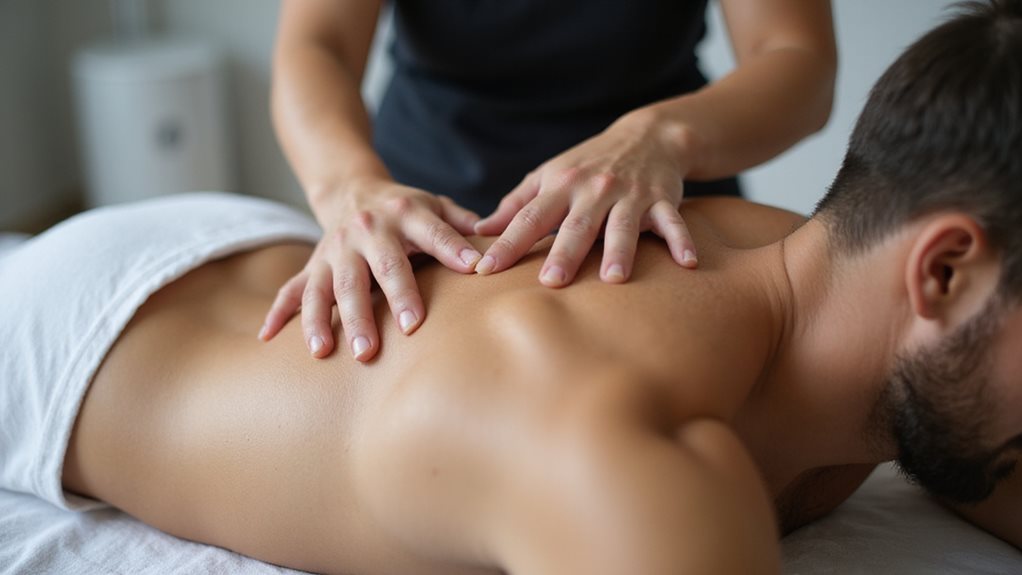Trigger Point Therapy offers a targeted approach to managing musculoskeletal pain by addressing hyperirritable nodules in muscle tissue. Clinicians employ different techniques, such as ischemic compression and dry needling, to alleviate discomfort and restore function. Supported by clinical evidence, these methods aim to disrupt pain cycles and improve recovery.
Yet, the nuances of each technique and their specific applications warrant closer examination to fully grasp their therapeutic potential.
Key Takeaways
- Trigger point therapy targets hyperirritable muscle nodules to relieve pain and improve mobility.
- Ischemic compression applies sustained pressure to deactivate trigger points effectively.
- Dry needling uses thin needles to elicit twitch responses for immediate pain relief.
- Spray and Stretch combines cold spray with stretching for acute spasm relief.
- Micro-stripping breaks adhesions using thumb-over-thumb contact to enhance blood flow.
Understanding Trigger Points and Their Impact
Trigger points, often described as hyperirritable nodules within taut bands of muscle or fascia, represent a critical focus in musculoskeletal pain management. These palpable “knots,” found in regions like the trapezius, exhibit tenderness and referred pain patterns, impacting daily comfort. For those seeking relief, understanding trigger point therapy explained offers a pathway to belonging within a community of care.
Their development stems from muscle ischemia, chronic tension, or postural distortions, leading to metabolic stress and central sensitization. This results in limited mobility, neuromuscular imbalances, and even autonomic symptoms like localized edema. By recognizing these effects, people join a shared expedition toward healing, where evidence-based approaches target these irritable zones to restore function and alleviate persistent discomfort effectively.
Additionally, trigger points can significantly restrict blood flow, contributing to a metabolic crisis that exacerbates pain and muscle tightness.
Overview of Spray and Stretch Methods
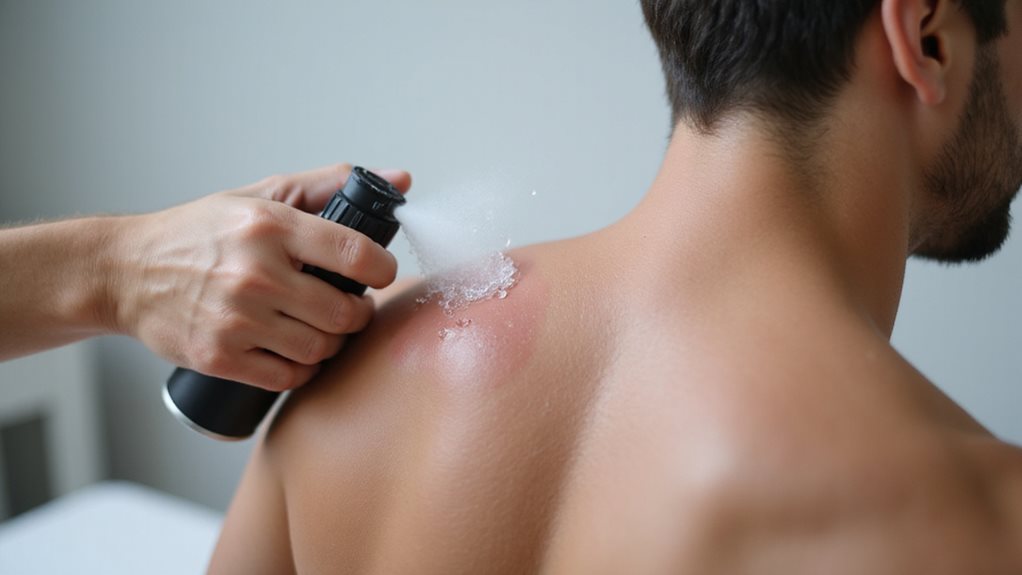
While many approaches exist for managing musculoskeletal pain, the spray and stretch method stands out as a noninvasive technique that synergistically combines cold-induced counterstimulation with mechanical muscle elongation. This method employs a cold spray to provide temporary analgesia, activating competing nerve pathways via the gate control mechanism to reduce discomfort during stretching. Applied at a 30° angle from 20-50 cm, the spray covers affected muscle regions, followed by immediate, gentle elongation to enhance relaxation.
Suitable for acute spasms, restricted motion, or needle-averse patients, this evidence-backed approach, endorsed by Travell & Simons as highly effective, integrates seamlessly into broader therapeutic plans. Clinicians often pair it with pre-treatment warming and post-procedure exercises, ensuring safety and fostering a sense of shared healing within the community. Additionally, this technique is widely recognized for its role in trigger point therapy, supporting pain management in various muscle-related conditions.
Benefits of Anesthetic Spray in Pain Relief
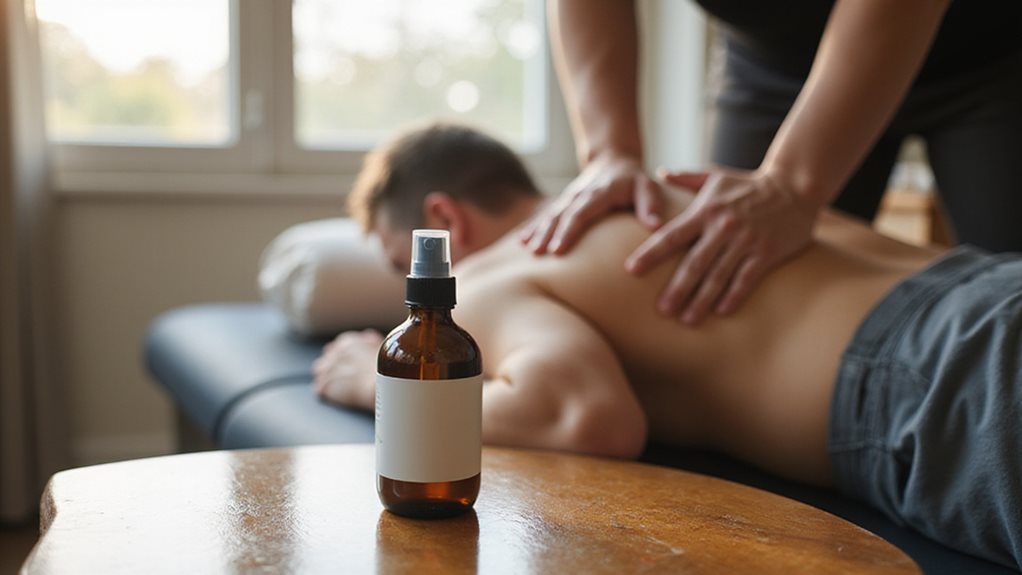
Exploring the role of anesthetic spray in pain relief reveals its significant impact on managing musculoskeletal discomfort. This topical solution offers rapid anesthesia by chilling sensory nerve endings, transforming dull pain into a sharp, manageable sensation. Widely used in clinical settings like physical therapy and sports medicine, it proves effective for chronic pain and trigger point management.
Its benefits include:
- Enhanced Efficacy: Complements spray-and-stretch therapy, facilitating more profound muscle relaxation.
- Reduced Discomfort: Minimizes treatment pain with cold anesthesia, avoiding needle-related anxiety.
- Speedy Recovery: Accelerates muscle relaxation, improving stretch outcomes and functional return.
- Safe Application: Offers a less invasive alternative to injections, ensuring patient comfort.
This approach fosters a supportive environment for those seeking relief within therapeutic communities. Additionally, the anesthetic spray aligns with nonpharmacologic treatments by providing a cooling effect that blocks pain sensation during muscle stretching.
Exploring Passive Stretching for Muscle Relaxation
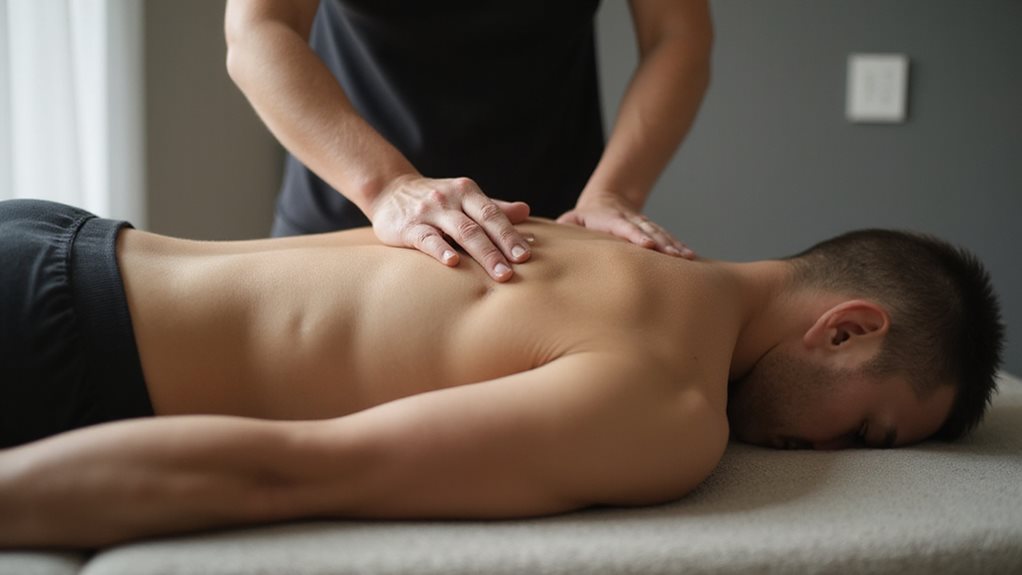
Many practitioners recognize passive stretching as a critical component in the management of muscle relaxation and trigger point therapy. This technique, separate from active stretching, relies on external force application, making it suitable for those with limited mobility. While not effective in isolation, passive stretching excels when paired with adjuncts like heat therapy or manual massage, enhancing neuromodulation to block pain signals.
Evidence supports its integration into multimodal protocols, with a recommended frequency of 2-3 times daily alongside trigger point deactivation for sustained relief. It targets hyperalgesic zones, aids chronic pain management, and supports post-traumatic recovery. Additionally, passive stretching can be particularly beneficial in addressing palpable taut bands associated with trigger points, helping to release tension in affected muscle fibers.
For our community seeking practical solutions, passive stretching, when combined strategically, offers a valuable tool for restoring comfort and mobility.
Mastering Ischemic Compression Approaches
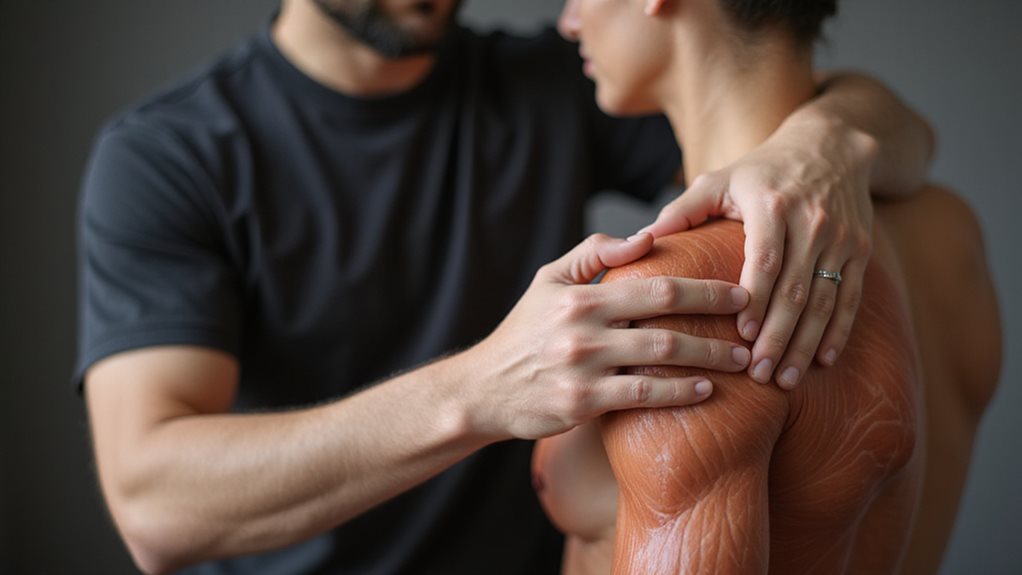
Precision in pain management often hinges on mastering ischemic compression, a cornerstone technique in trigger point therapy. This method targets trigger points by applying sustained pressure to modulate pain through neurophysiological mechanisms like Descending Noxious Inhibitory Control (DNIC) and improved local blood flow, avoiding forced ischemia. For practitioners and patients seeking effective relief, understanding its application fosters a shared path toward recovery.
Additionally, the technique relies heavily on patient feedback to locate and address trigger points precisely, ensuring that tailored treatment is crucial.
Key aspects include:
- Pain Modulation: Activates central nervous system pathways to inhibit pain signals.
- Muscle Tension Release: Relaxes contracted sarcomeres with controlled pressure.
- Patient Tolerance: Adjusts force to discomfort thresholds, ensuring comfort.
- Immediate Outcomes: Often improves range of motion post-session.
This evidence-based approach, when applied consistently, strengthens communities to address muscle dysfunction collaboratively and effectively.
Tools and Tactics for Effective Pressure Application
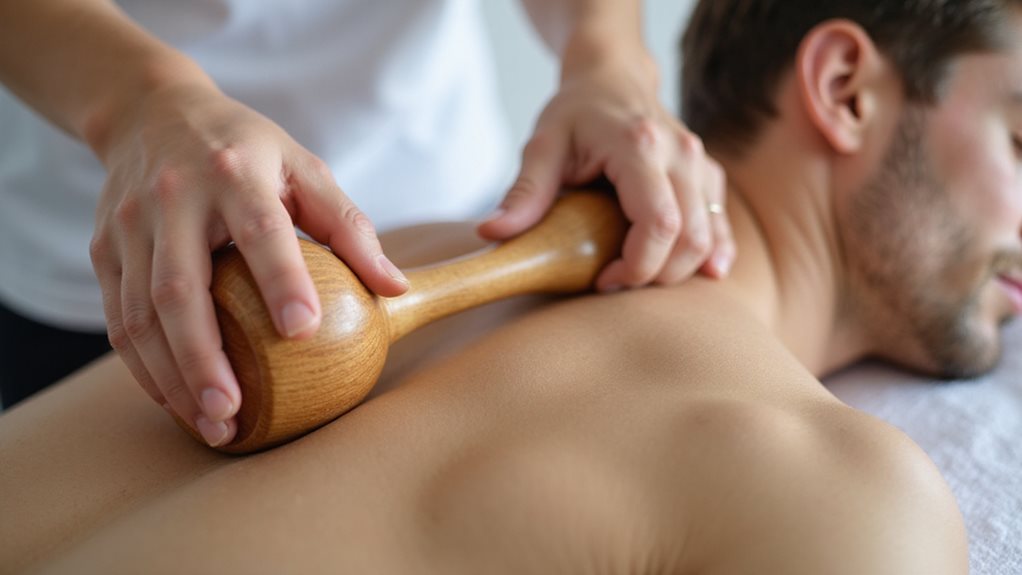
Effective trigger point therapy relies on the strategic use of crucial pressure tools and ideal application tactics to target muscular dysfunction. Research supports the efficacy of tools like trigger point canes for deep tissue access and manual techniques such as sustained moderate pressure for accessible areas, both tailored to patient feedback. These methods, when applied with precision for durations not exceeding 90 seconds, aim to enhance therapeutic outcomes while minimizing discomfort.
Additionally, consistent application of these techniques is vital to break the cycle of pain caused by muscle spasms and restricted blood flow.
Essential Pressure Tools
People seeking relief from muscle tension and trigger points can benefit from a diverse array of pressure tools designed for targeted application. These instruments, ranging from basic to clinical-grade, cater to varied therapeutic needs within a supportive community of wellness seekers. Research highlights their efficacy in addressing myofascial pain through precise pressure.
Explore these vital tools for effective relief:
- Foam Rollers: Tools like TriggerPoint GRID Vibe Plus improve deep tissue penetration with vibration.
- Hand-Held Devices: Thera Cane Massager allows self-treatment of hard-to-reach areas.
- Therapeutic Scrapers: Rechargeable heated scrapers offer professional myofascial release.
- Foot Rollers: Textured wheels target the plantar fascia for athletes.
These tools enable people to manage pain and foster a shared experience toward healing. Additionally, resources such as instructional videos can enhance the effectiveness of these tools by providing visual guidance on proper techniques.
Optimal Application Tactics
Persons seeking relief from trigger points must understand that the right tools are only part of the solution; applying pressure with proper tactics is likewise crucial for therapeutic success. Evidence supports manual sustained pressure for up to 90 seconds or intermittent tool-based cycles of 10 seconds, repeated five times per trigger point, to optimize deactivation. Moderate, response-based intensity prevents soreness while ensuring efficacy, with stronger pressure for deep tissue and lighter pressure for surface points.
Techniques such as Simons’ Trigger Point (TrP) pressure release emphasize the gradual application of pressure to minimize discomfort. Complementary methods like positional release, progressive stretching, and gravity-assisted pressure further enhance treatment outcomes. The integration of hybrid approaches, such as dry needling with manual therapy, promotes more comprehensive relief and supports inclusion in a collaborative, results-focused trigger point care environment.
Additionally, ischemic compression, a cornerstone of manual trigger point therapy, can significantly improve local blood flow, amplifying therapeutic effects.
Micro-Stripping for Breaking Muscle Adhesions
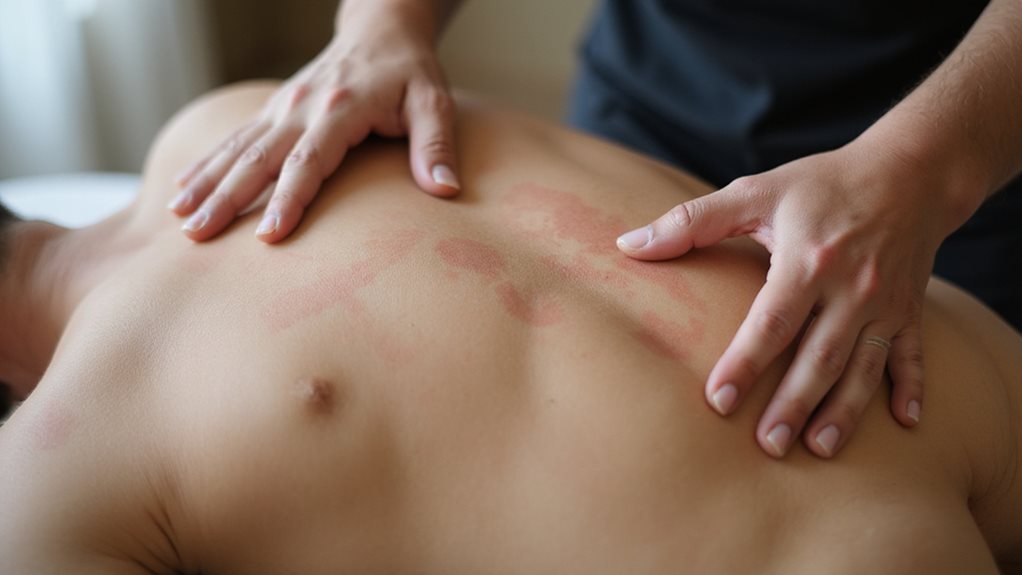
Micro-stripping, a precise manual technique, employs thumb-over-thumb contact with brief stripping strokes parallel to muscle fibers to effectively target adhesions. This method disrupts constricted collagen sheaths surrounding muscle cells, facilitating the breakdown of adhesive formations through controlled pressure and skin movement over muscle. As a result, it promotes improved blood flow to ischemic areas, aiding in the release of restricted myocytes and enhancing muscle fiber alignment.
Notably, this technique ensures that contact moves the skin over the muscle rather than sliding across it, maximizing the therapeutic impact on the skin over the muscle.
Micro-Stripping Technique Basics
The micro-stripping technique emerges as a targeted approach within trigger point therapy to address muscle adhesions. This method focuses on precise, controlled movements to address tension in muscle fibers, offering practitioners a valuable tool for effective intervention. Its clinical application requires skill and understanding of muscle anatomy to guarantee ideal outcomes for clients seeking relief.
Key aspects of the micro-stripping technique include:
- Thumb-over-thumb contact: Utilizes supported thumb pressure for short, deliberate strokes along muscle fibers.
- Surface gliding: Moves skin over underlying tissue to minimize direct friction.
- Fiber alignment: Targets strokes parallel to muscle grain for maximum effect.
- Controlled depth: Applies consistent, shallow pressure to avoid tissue damage.
This technique fosters a sense of care and connection in therapeutic practice. By incorporating advanced methods like micro-stripping, therapists can significantly enhance blood flow and tension reduction in affected muscles, promoting faster recovery and relief for patients.
Breaking Adhesion Process
As a tailored application of trigger point therapy, the micro-stripping technique plays an essential role in breaking muscle adhesions through targeted, controlled pressure. This method applies physiological force to alter cellular elasticity, facilitating collagen fiber adjustment while improving lymphatic drainage to reduce inflammation. Techniques like deep tissue massage and active release therapy are often integrated, using cross-fiber friction to dismantle scar tissue effectively.
Understanding the process is crucial for those seeking relief and connection through healing. Below is a concise overview of key mechanisms. Additionally, the role of fascia as supportive connective tissue is vital, as it surrounds muscle groups and aids in maintaining stability during these therapeutic interventions.
| Mechanism | Effect on Adhesions |
|---|---|
| Pressure Application | Restricts blood flow, then increases oxygenation |
| Thermal Therapy | Softens adhesions via increased circulation |
| Friction-Induced Heat | Improves enzymatic collagen breakdown |
| Lymphatic Drainage | Reduces inflammation by waste removal |
Muscle Fiber Benefits
Practitioners employing micro-stripping techniques for breaking muscle adhesions observe significant benefits to muscle fiber health through targeted therapeutic intervention. This method meticulously addresses structural integrity and functional restoration, fostering a sense of recovery and connection for those seeking relief within a supportive therapeutic community. By focusing on fascial tissues, this technique also helps release tension in tight areas, contributing to overall muscle relaxation and pain relief.
Key advantages include:
- Enhanced Circulation: Increases blood flow and oxygen delivery to ischemic muscle regions.
- Structural Alignment: Promotes proper muscle fiber orientation and reduces collagen cross-linking.
- Pain Reduction: Targets hyperirritable bundles, diminishing localized pain and neural irritation.
- Mobility Improvement: Restores range of motion and muscle extensibility for dynamic movement.
Insights Into Dry Needling Practices
What distinguishes dry needling as an effective treatment for musculoskeletal pain? Unlike acupuncture, dry needling targets explicitly hypersensitive myofascial trigger points (MTrPs) using thin, sterile monofilament needles to disrupt dysfunctional muscle activity. The elicitation of a local twitch response (LTR) signals accurate needle placement.
It is often associated with immediate pain relief, improved circulation, and a reduction in pain-related chemicals such as substance P.
For those seeking relief within a supportive clinical community, dry needling offers a precise approach for chronic pain, tension headaches, and restricted motion. Sessions, lasting 10–30 minutes, focus on 3–5 MTrPs, with mild post-needling soreness resolving quickly. Paired with stretching and manual therapy, it integrates seamlessly into thorough care, guided by certified practitioners ensuring safety and efficacy.
Research also shows that combining dry needling with manual therapy and exercise can significantly enhance pain outcomes.
Role of Local Anesthetic Injections in Treatment
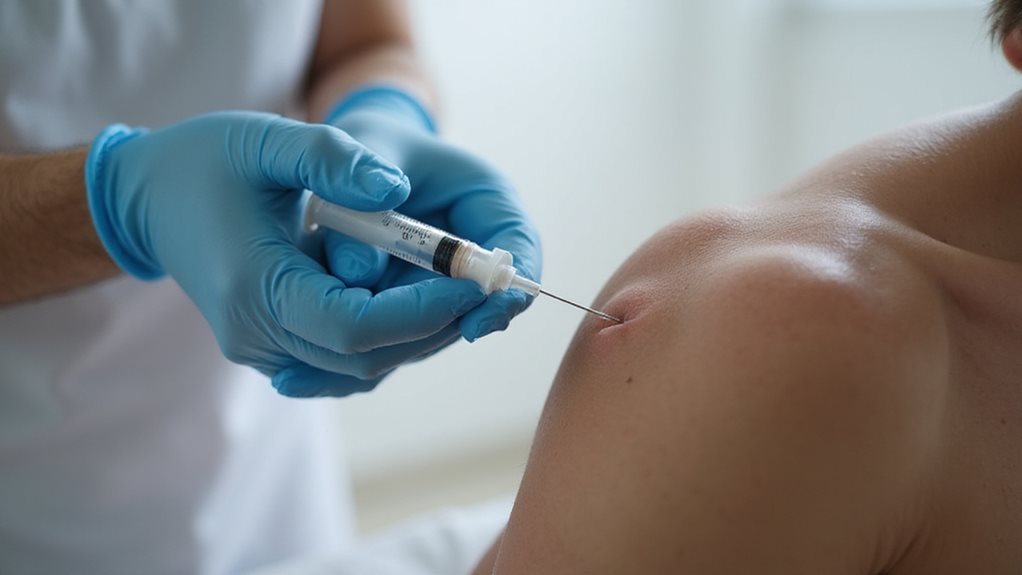
Local anesthetic injections play a critical role in trigger point therapy by targeting hyperirritable spots in taut muscles through mechanisms such as sodium channel inhibition and local vasodilation, which reduce pain signal propagation. Clinical evidence supports their benefits, including significant pain relief lasting up to one month and superior outcomes compared to dry needling in visual analog scores. However, risks such as adverse reactions in patients with hypersensitivity to anesthetics must be considered, alongside the generally low incidence of complications when protocols are followed.
Additionally, these injections can improve range of motion and muscle functionality for many patients after treatment.
Mechanism of Action
Although trigger point injections (TPIs) are widely utilized in managing musculoskeletal pain, their efficacy hinges on precise mechanisms involving local anesthetics. These injections target hyperirritable trigger points, disrupting pain cycles through pharmacological and mechanical means. Local anesthetics like lidocaine block sodium channels, halting pain signal transmission to the central nervous system, while also relaxing muscle fibers.
Key mechanisms include:
- Pain Pathway Disruption: Immediate numbing reduces sensory input, stopping nociceptive signaling.
- Sodium Channel Blockade: Prevents neuron depolarization, inhibiting pain propagation.
- Muscle Relaxation: Overrides aberrant signals, easing spasms and improving perfusion.
- Tissue Mechanics: Injection pressure disrupts taut bands, releasing tension.
This targeted approach fosters relief, connecting patients to a community of effective pain management strategies through clinical precision. Additionally, the action of local anesthetics promotes improved blood flow to the affected area, enhancing tissue healing.
Benefits and Risks
Precision in pain management remains a cornerstone of local anesthetic injections, specifically in the treatment of myofascial trigger points. These injections, often using lidocaine, offer significant pain relief, with clinical response rates of 80% at one week and 73.3% at 12 weeks. They improve range of motion, reduce analgesic use, and support rehabilitation participation.
Risks, though minimal when performed correctly, include temporary soreness and uncommon nerve block near injection sites. The table below highlights key comparative outcomes, fostering a shared understanding of treatment efficacy.
| Treatment | Efficacy | Side Effect Profile |
|---|---|---|
| Lidocaine Injection | Superior to compression | Temporary soreness |
| Dry Needling | Equal to lidocaine | Different risks |
| Normal Saline | Similar in some cases | Lower cost, reduced effect |
When to Consider Steroid Injections for Chronic Pain
How should clinicians approach the use of steroid injections for managing chronic pain? The decision requires careful evaluation of evidence, balancing short-term relief against long-term limitations. While epidural injections offer marginal benefits for leg pain (MD −4.93 short-term), efficacy often erodes by 3 months, and chronic pain (≥12 months) shows minimal improvement compared to placebo.
Consider these key factors for informed decisions:
- Condition Specificity: Lumbar radiculopathy may see temporary relief, unlike chronic sacroiliac dysfunction, where PRP outperforms steroids.
- Responder Identification: Neck pain screening protocols improve outcome predictions.
- Risk Assessment: Complications like infection or hyperglycemia warrant caution.
- Acute vs. Chronic: Acute flare-ups respond better, with 60–70% recovery by 6 weeks.
Clinicians must weigh these elements, ensuring patients feel supported in shared decision-making.
Manual Massage Strategies for Tension Relief
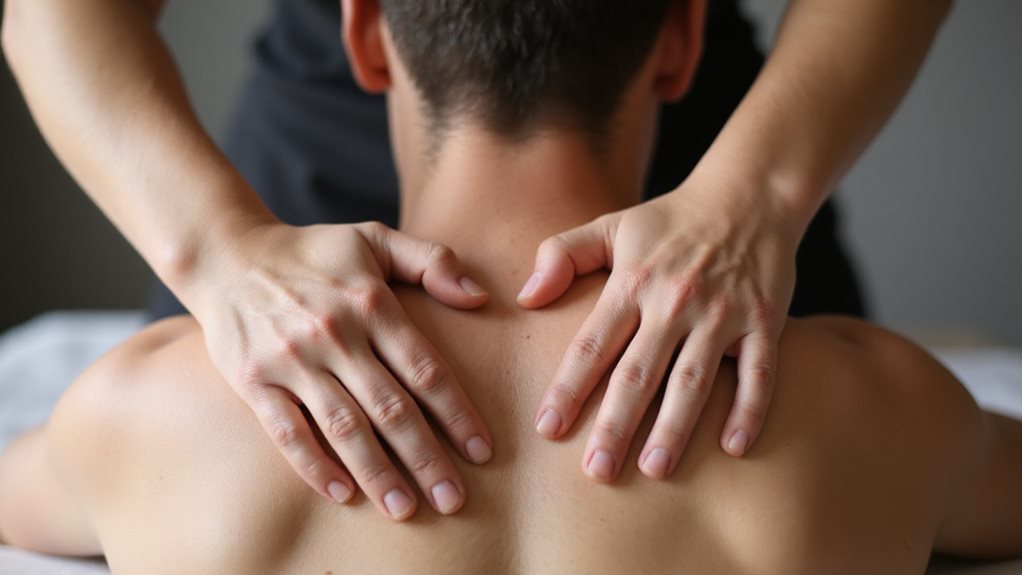
Within the scope of manual massage strategies for tension relief, deep stroking techniques offer significant benefits by enhancing blood circulation and promoting muscle fiber relaxation in targeted areas. Likewise, acupressure provides a focused approach to tension relief, applying precise pressure to specific points to reduce pain and improve tissue response, as supported by clinical observations. These methods, when used with appropriate intensity and duration, can effectively address trigger point discomfort and associated muscular strain.
Deep Stroking Benefits
Many people experience significant relief from chronic tension through deep stroking, a manual massage strategy integral to trigger point therapy. This technique targets deep muscle layers, releasing chronic tension and improving blood flow to oxygenate damaged tissues. It also reduces inflammation and breaks scar tissue adhesions, fostering recovery.
Key benefits of deep stroking include:
- Pain Relief: Replaces tension-related pain with endorphin release.
- Stress Reduction: Lowers cortisol levels and promotes mental calm.
- Posture Improvement: Loosens tight muscles, causing misalignment.
- Muscle Recovery: Boosts circulation and removes metabolic waste.
Acupressure Tension Relief
Practitioners often turn to acupressure as a targeted manual massage strategy for tension relief, focusing on specific pressure points to alleviate discomfort. By applying moderate force through circular motions or sustained pressure for 2–3 minutes at sites like the neck/shoulder junction or between the eyebrows, people can experience reduced tension and stress. This technique improves circulation, promotes autogenic inhibition, and modulates central nervous system pain signals, fostering muscle relaxation and recovery.
For the community seeking holistic relief, acupressure offers accessible benefits, from easing headaches to supporting post-exercise recovery. Tools like tennis balls aid hard-to-reach areas, while safety remains paramount. Avoiding excessive force prevents trauma. Together, these practices enable individuals to manage chronic tension effectively and belong to a shared wellness experience.
Combining Heat and Cold for Enhanced Recovery
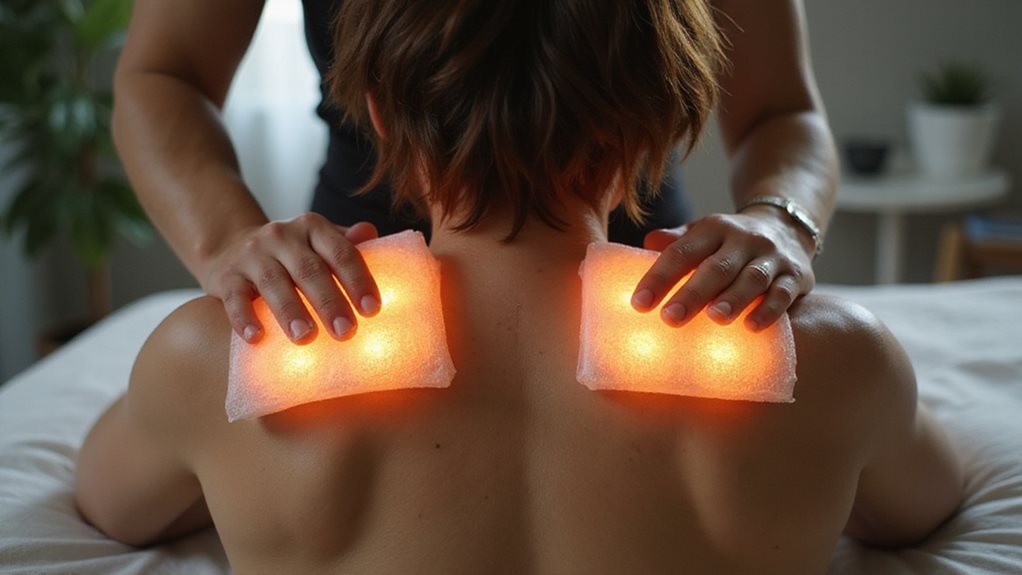
Although recovery strategies often focus on personal modalities, combining heat and cold therapy offers a synergistic approach to improve healing across multiple phases of injury. This dual method utilizes physiological responses like vasoconstriction from cold to reduce edema and vasodilation from heat to amplify oxygen delivery, fostering recovery.
Key benefits of this combined approach include:
- Acute relief: Cold therapy controls inflammation within the initial 24 hours.
- Subacute shift: Heat aids muscle relaxation after 24–48 hours.
- Chronic support: Sustained heat targets stiffness in later stages.
- Contrast cycles: Alternating temperatures in protocols like contrast water therapy enhance blood flow.
Ultrasound and Diathermy in Deep Tissue Healing
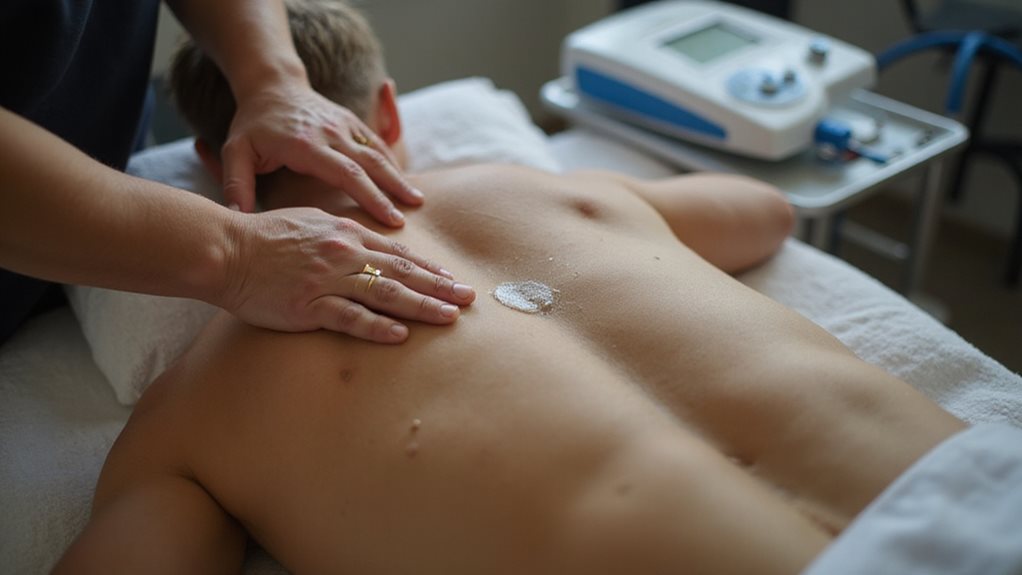
While different modalities exist for deep tissue healing, ultrasound and diathermy stand out as targeted interventions for musculoskeletal recovery. Diathermy, with its deeper penetration, excels in treating larger areas and non-insertional tendon disorders. As supported by Grade B evidence, it outperforms ultrasound in pain reduction for tendinopathy and chronic lower back pain.
Ultrasound, conversely, suits superficial injuries and acute conditions.
| Aspect | Diathermy |
|---|---|
| Penetration Depth | Deeper, beyond ultrasonography |
| Pain Relief Efficacy of Ultrasound | in tendinopathy (Grade B) |
| Tissue Repair | Improves tendon elasticity |
| Application Focus | Deep tissue, post-surgical rehab |
| Clinical Outcome | Better ROM in tendon repair studies |
Both modalities, when integrated with physical therapy, offer our community effective paths to recovery.
Harnessing TENS for Pain Signal Disruption.
Transcutaneous Electrical Nerve Stimulation (TENS) is a proven method for relieving pain by interrupting pain signals along specific nerve pathways. It works by engaging the body’s natural pain control systems—both at the spinal level (segmental inhibition) and through brain pathways (descending pain modulation). TENS helps reduce heightened pain sensitivity (hyperalgesia) and central nervous system overactivity (central sensitization), making it a powerful option for pain relief in a supportive therapeutic setting.
Key mechanisms include:
- Activation of Aβ fibers to inhibit nociceptive Aδ/C fiber transmission.
- Release of serotonin and norepinephrine for descending pain suppression.
- High-frequency settings (>50 Hz) to engage supraspinal control pathways.
- Portable application for immediate, accessible pain relief.
This evidence-based approach integrates seamlessly into pain management strategies, enhancing physical therapy outcomes and fostering a sense of shared progress among users maneuvering through chronic pain challenges together.
Clinical Evidence Supporting Trigger Point Therapies
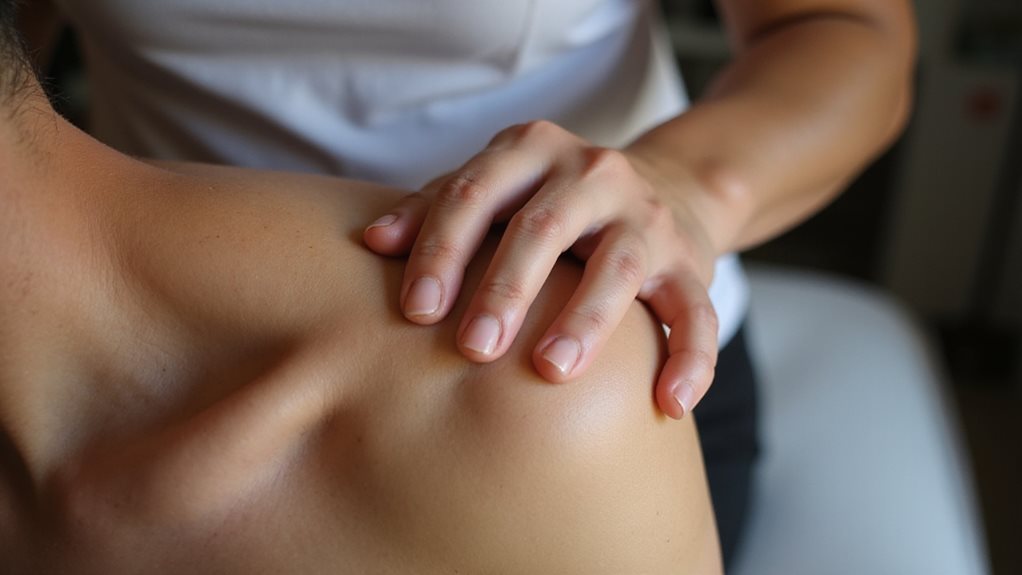
Researchers have extensively investigated the therapeutic potential of Transcutaneous Electrical Nerve Stimulation (TENS) for pain management, paving the way for a broader examination of clinical evidence behind trigger point therapies. Studies reveal manual trigger point therapy matches conservative treatments for orofacial myofascial pain, though evidence quality remains low due to bias and small samples. Dry needling and ischaemic compression show promise, especially in reducing headache intensity and duration in tension-type cases, while improving pain-pressure thresholds.
Massage protocols with sustained pressure offer short-term relief, assessed via algometers and scales like the Visual Analog Scale. Diagnostic tools, including manual palpation, standardize trigger point identification. Together, these findings foster a sense of shared progress in validating therapies for our community’s management needs.
Frequently Asked Questions:
How Long Does Trigger Point Therapy Last?
The duration of trigger point therapy varies. Research indicates immediate pain relief and short-term benefits, lasting weeks, specifically for headaches. However, sustained outcomes often require maintenance or combined therapeutic approaches.
Can Trigger Point Therapy Prevent Future Pain?
Evidence suggests trigger point therapy may help prevent future pain by reducing muscle stiffness and normalizing tension. When integrated with exercise, it shows promise in averting recurring discomfort and fostering a supportive recovery community.
Is Trigger Point Therapy Safe During Pregnancy?
Imagine a serene passage through pregnancy, with comfort within reach. Evidence confirms trigger point therapy, showing no increased risk of pregnancy or miscarriage. Join a community embracing this reassuring, clinically supported approach.
What Are Potential Side Effects of Therapy?
Potential side effects of therapy may include pain, bruising, or tenderness at the site, temporary numbness, dizziness, and fatigue. Uncommon complications like infection or allergic reactions can occur, necessitating careful monitoring and support.
How Often Should Therapy Sessions Be Scheduled?
Therapy session scheduling typically begins with weekly sessions for 4–6 weeks to address chronic issues. Based on progress, the frequency may adjust to biweekly or monthly, ensuring customized care for ideal recovery and support.
Conclusion
To sum up, trigger point therapy emerges as a guiding light of relief, painting a vivid picture of muscles unshackling from pain’s grip through precise technique, pain-shemic compression, and Spray and Stretch. Imagine tension dissolving under skilled hands, blood flow reviving weary fibers, as clinical evidence underscores these methods ‘ efficacy. This therapeutic artistry, inspired by science, restores mobility and calm, offering patients a tangible path to healing in a landscape of chronic discomfort.
